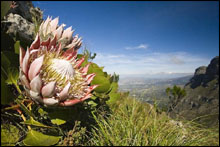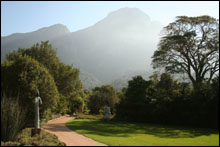SAEON Fynbos Node set to provide data platform for biodiversity hotspot
|
In March this year, Prof Mzamo Mangaliso, President and CEO of the
National Research Foundation (NRF), the parent body of SAEON, and Mr
Sunjit Singh, Acting CEO of the South African National Biodiversity
Institute (SANBI) signed an agreement for SANBI to host a new SAEON
Node in the Cape Floral Kingdom (CFK) at the Kirstenbosch National
Botanical Garden in Cape Town.
The new node is known as the SAEON Fynbos Node. It was the Dutch settlers who first described the hardy plants of the Cape as “fijnbosch”, meaning “fine-leafed bushes”. Today the term fynbos describes all the diverse types of plants, proteas, ericas, restios, grasses and geophytes that have evolved to survive on the nutrient-poor soils, high winds and dry summers that characterise the southern tip of Africa.
A considerable body of knowledge exists within the CFK and much of this is reliant on historical and ongoing long-term observation programmes already stretching over many decades.
"The initiative by SAEON to provide a node for long-term CFK observations at multiple scales and a data connection is widely hailed by the observation science community as important and timely," said Johan Pauw, Head of SAEON, "as much data is in danger of being lost due to individuals leaving the system, or not having been digitised or not being supported by adequate metadata."
Dr Nicky Allsopp, the newly appointed Manager of the SAEON Fynbos Node will explore the potential of integrating the Node’s activities with other programmes, including C.A.P.E. (Cape Action for People and the Environment), the Cape Floristic Kingdom World Heritage Site (WHS), Western Cape's State of the Environment (SoE) Reporting initiative, the educational programme of the University of Cape Town's Institute for Plant Conservation (IPC) and the Little Karoo Study Group. CAPE NATURE reserves will provide important sites and data for the observation system that the Node will coordinate.
Dr Allsopp will also be working closely with the SAEON Elwandle Node regarding coastal observations and the upcoming node in Kimberley for arid biomes and systems. It became abundantly clear during the C.A.P.E. planning process in 2003-2004 that many environmental changes are linked across the major ecosystem types' boundaries and one cannot fully understand environmental changes in a particular ecosystem unless one knows what is happening in the adjacent ecosystems.
Four of the designated five fynbos node sites include (or could include by simple extension into the adjacent marine areas) all four major ecosystem types. Many have marine protected areas adjacent to their shoreline and include a range of different estuary types.
Fynbos Biome
The Fynbos Biome is considered by many to be synonymous with the Cape Floristic Region (CFR) or Cape Floral Kingdom (CFK). However, the "biome" refers only to the two key vegetation groups (Fynbos and Renosterveld) within the region, whereas both the "region" and the "kingdom" refer to the general geographical area and include other vegetation types in the Forest, Nama Karoo, Succulent Karoo and Thicket Biomes, but exclude peripheral outliers of the Fynbos Biome such as the Kamiesberg, North-western and Escarpment Mountain Renosterveld and Grassy Fynbos east of Port Elizabeth.
However, the contribution of Fynbos vegetation to the species richness, endemicity and fame of the region is so overwhelming, that the CFR and CFK can be considered to be "essentially fynbos."
The two major vegetation groupings in fynbos are quite distinct and have contrasting ecological systems. Essentially, renosterveld used to contain the large animals in the CFK, but these are now extinct or else have been reintroduced into conservation areas.
By contrast, fynbos is much richer in plant species, but has such
poor soils that it cannot support even low densities of big game.
However, most of the endemic amphibian, bird and mammal species in the
region occur in fynbos vegetation types.
Cape Floral Kingdom
The CFK represents less than 0.5% of the area of Africa, but is home to nearly 20% of the continent's flora.
As the only floral kingdom to be located entirely within the geographical confines of one country, it harbours 9 000 different species - 6 000 of which are found nowhere else on earth - in eight protected areas in an area of 90 000 square kilometers stretching from the Cape Peninsula to the Eastern Cape. It contains the highest density of plant species in the world, exceeding that of many tropical rainforest systems and is the 6th South African Site to be inscribed on the World Heritage List of the United Nations Educational, Scientific and Cultural Organisation (UNESCO).
By far the smallest of the world’s six plant kingdoms, its plant
species diversity, density and endemism are among the highest
worldwide. Due to its concentration of endemic taxa, its large number
of species, and its vulnerability to processes that threaten its unique
biodiversity, the CFR is recognized globally as one of the world's 18
biodiversity hotspots.
By comparison the British Isles, which are three and a half times
larger, have 1 500 species of which only 20 are endemic.
The rich biodiversity of the CFR is due to an extensive and complex array of habitat types derived from topographical and climatic diversity in the region's rugged mountains, fertile lowlands, simi-arid shrublands and coastal dunes.
In the lowlands, fynbos is replaced by renosterveld (Afrikaans for "rhinoceros scrub"), an ericoid shrubland, and coastal dunes and thickets that sustain an extremely high density of plants and animals threatened with extinction. Because the fynbos biosphere encompasses so many different biomes, it naturally boasts a rich variety of bird species. Some 360 species live, breed or visit here.
Over 7 000 of the CFK’s plant species occur in only five fynbos vegetation types, with perhaps an additional 1 000 species in the three renosterveld vegetation types. The contribution of Succulent and Nama Karoo, Thicket and Forest vegetation types in the region to the plant species diversity is thus relatively small.
Thus, although the CFK contains five biomes, only the Fynbos Biome, comprising the fynbos and renosterveld vegetation groups, contains most of the floral diversity. Furthermore, the Cape Floral Kingdom traditionally does not include the Fynbos and Renosterveld vegetation outliers to the north and east. Including these would mean that endemicity would approach 80%, the highest level of endemicity on any subcontinent.
Distressingly, some three-quarters of all plants in the South African Red Data Book occur in the Cape Floral Kingdom: 1 700 plant species are threatened to some extent with extinction! This is much more than one would expect based on either the area of the Kingdom (6%) or its plant numbers (36%). The highly endangered renosterveld has been reduced to less than 3% of what used to be there.
This vulnerability again reflects the unique nature of Fynbos vegetation: many Fynbos species are extremely localised in their distribution, with sets of such localised species organised into "centres of endemism." The city of Cape Town sits squarely on two such centres of endemism and several hundred species are threatened by urban expansion.
However, a more serious threat is alien plants, which infest large tracts of otherwise undisturbed mountains and flats: their impact on these extremely localised species is severe.
On the lowlands the major threat is agriculture - new technologies, fertilisers and crops are steadily eating into our floral reserves. Another important threat is the misuse of fire. Fynbos must bum, but fires in the wrong season (such as in spring, instead of late summer) or too frequently (so that plants do not have time to set seed) eliminate species. Several factors influence fire dynamics in fynbos global warming, grazing practices and fire management (ignition events, size of burns), but their relative importance and interactions are poorly understood.
Underlying causes for the current state of the biodiversity in the
region include lack of capacity and poor co-ordination between bodies
responsible for the management of natural resources, lack of awareness
of the importance of biodiversity and the impacts of urgent measures to
meet the basic needs of society.
Related content:














